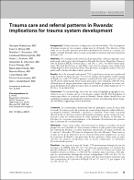| dc.contributor.author | Ntakiyiruta, Georges | |
| dc.contributor.author | Wong, Evan G | |
| dc.contributor.author | Rousseau, Mathieu C | |
| dc.contributor.author | Ruhungande, Landouald | |
| dc.contributor.author | Kushner, Adam L | |
| dc.contributor.author | Liberman, Alexander S | |
| dc.contributor.author | Khwaja, Kosar | |
| dc.contributor.author | Dakermandji, Marc | |
| dc.contributor.author | Wilson, Marnie | |
| dc.contributor.author | Razek, Tarek | |
| dc.contributor.author | Kyamanywa, Patrick | |
| dc.contributor.author | Deckelbaum, Dan L | |
| dc.date.accessioned | 2022-04-25T12:47:34Z | |
| dc.date.available | 2022-04-25T12:47:34Z | |
| dc.date.issued | 2016 | |
| dc.identifier.citation | Ntakiyiruta, G., Wong, E.G., Rousseau, M.C., Ruhungande, L., Kushner, A.L., Liberman, A.S., Khwaja, K., Dakermandji, M., Wilson, M., Razek, T. and Kyamanywa, P. (2016). Trauma care and referral patterns in Rwanda: implications for trauma system development. Canadian journal of surgery, 59(1), p.35. | en_US |
| dc.identifier.issn | 0008-428X / 1488-2310 | |
| dc.identifier.uri | http://hdl.handle.net/20.500.12280/2959 | |
| dc.description.abstract | Background: Trauma remains a leading cause of death worldwide. The development of trauma systems in low-resource settings may be of benefit. The objective of this study was to describe operative procedures performed for trauma at a tertiary care facility in Kigali, Rwanda, and to evaluate geographical variations and referral patterns of trauma care.
Methods: We retrospectively reviewed all prospectively collected operative cases performed at the largest referral hospital in Rwanda, the Centre Hospitalier Universitaire de Kigali (CHUK), between June 1 and Dec. 1, 2011, for injury-related diagnoses. We used the Pearson χ2 and Fisher exact tests to compare cases arising from within Kigali to those transferred from other provinces. Geospatial analyses were also
performed to further elucidate transfer patterns.
Results: Over the 6-month study period, 2758 surgical interventions were performed at the CHUK. Of these, 653 (23.7%) were for trauma. Most patients resided outside of Kigali city, with 337 (58.0%) patients transferred from other provinces and 244 (42.0%) from within Kigali. Most trauma procedures were orthopedic (489 [84.2%]), although general surgery procedures represented a higher proportion of trauma surgeries in patients from other provinces than in patients from within Kigali (28 of 337 [8.3%] v. 10 of 244 [4.1%]).
Conclusion: To our knowledge, this is the first study to highlight geographical variations in access to trauma care in a low-income country and the first description of trauma procedures at a referral centre in Rwanda. Future efforts should focus on maturing prehospital and interfacility transport systems, strengthening district hospitals and further supporting referral institutions. | en_US |
| dc.language.iso | en | en_US |
| dc.publisher | Cma-Canadian Medical Assoc , 1867 Alta Vista Dr, Ottawa, Canada, Ontario, K1g 5w8 | en_US |
| dc.relation.ispartofseries | Canadian journal of surgery;59(1) | |
| dc.subject | Trauma care | en_US |
| dc.subject | Referral patterns | en_US |
| dc.subject | Rwanda | en_US |
| dc.subject | Trauma system | en_US |
| dc.title | Trauma Care and Referral Patterns in Rwanda: Implications for Trauma System Development | en_US |
| dc.type | Article | en_US |


